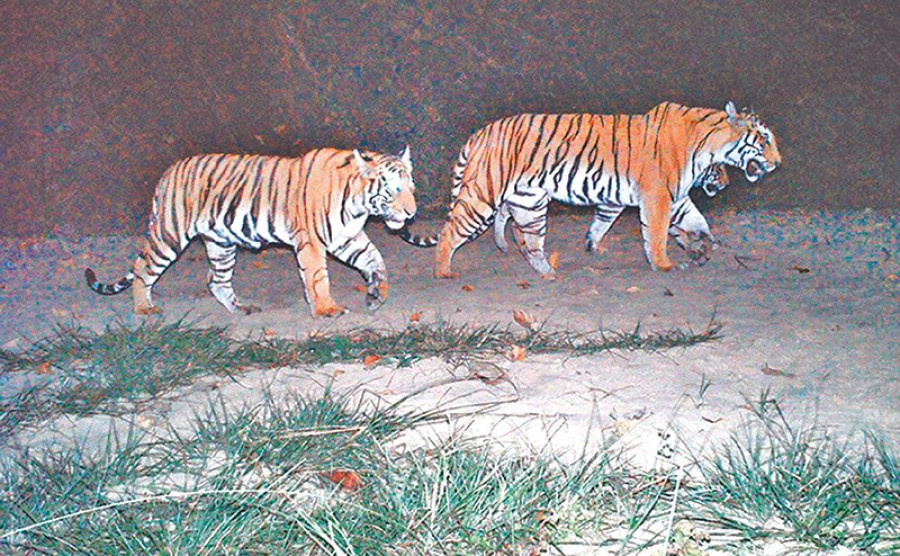Climate & Environment
Prey density declines across tiger bearing parks and forests
According to the survey, the prey densities, significant for maintaining and boosting wildcat population, had decreased from 25.33 to 22.02 prey number in per square kilometre in Parsa National Park.
Chandan Kumar Mandal
Last year in September, Nepal grabbed global headlines for nearly doubling its tiger population in a decade, an achievement that also put Nepal ahead of the countries that had made a pledge to double their wildcat population from their base number.
Now, with just three years left, Nepal is most likely to achieve the target because of its years of tiger conservation efforts, strict check on poaching, management of habitat, among other forms of intervention.
However, overlooked in the national tiger census report, which was released in September last year, is prey density, which has marginally declined across all protected areas when compared with the last census.
According to the survey, the prey densities, significant for maintaining and boosting wildcat population, had decreased from 25.33 to 22.02 prey number in per square kilometre in Parsa National Park.
In Chitwan National Park—which is home to 93 adult tigers, the highest number of tigers in any protected area in the country—the density has gone down from 73.63 to 70.7.
Banke National Park had the lowest prey presence among other parks as it slipped down to 8.1 animals per square km from 10.27per square km since the last census. Bardiya National Park, which has shown impressive growth in tiger population, taking its number up to 87 from 50 in 2013, has witnessed a decline in prey density from 92.6 from 77.51 animals per square km. Likewise, the prey population has come down to 68.04 from 78.62 animals per square km in Shuklaphanta National Park.
“The tiger population is directly related to the prey density status in their habitat. If the presence of prey is good then it also reflects in the tiger population,” said Bishnu Prasad Shrestha, under-secretary and information officer with the Department of National Park and Wildlife Conservation.
According to the report, processes for estimating tiger prey density and tiger population took place simultaneously. Line transects—1.5 to 2 km long—were placed on 2X2 km camera trap grid cells. Two deployed personnel walked across the transect twice—either on foot or on elephant back—and took note of sighted species, group size, among others.
The report has also said that the lowering of density from the latest survey could be a result of difference in the study timeframe because the study was conducted in late morning during mid-winter, offering poor visibility of animals. In 2013, the survey was conducted in March-April when the weather was clear and the grass height shorter, making it possible to sight prey animals.
The department official added that the objective of the overall survey could also be a factor behind the decline recorded in the latest prey survey.
“Survey of both tiger and prey base was done together. However, this is not as detailed when it comes to recording prey, as the focus was on tiger census,” Shrestha told the Post. “But that doesn’t mean the study was incomplete in itself. It only means the primary focus was on tiger count and main prey animals.”
The prey animals recorded during the survey were four deer species (spotted deer, sambar, hog deer, barking deer), two antelopes (blue bull and four-horned antelope), wild boar, gaur, and two primate species (rhesus macaque and langur).
The report further pointed out that another possible reason for the decline in prey density could be the floods of 2017 and 2015. The flood in 2017 that wreaked havoc in all the Southern plain districts, and had killed many wild animals inside the Chitwan National Park. A similar flood in Bardia in 2015 had also killed animals that are among the preferred prey for wild cats.
The low count of prey in parks was also attributed to the straight-line method of distance sampling during the survey which avoided hilly terrains.
“The Chure range was excluded in the survey so prey living around that could not be counted. However, the presence of tigers in Chure ranges have been recorded which means prey animals are there,” Shrestha said.
The department has now started a separate prey base status study across all wildlife parks and adjoining forest. This time, the focus will be mainly on prey.
“Unlike the previous study, this will be concentrated on prey status and will also cover the Chure range, where tigers have been sighted,” Shrestha told the Post.
The study is completed in Shuklaphanta National Park whereas it is near completion in Banke and Bardiya National Park. The survey has recently begun in Chitwan and Parsa Complex that combines Chitwan and Parsa National Park. Authorities believe the findings will help them revisit their conservation efforts and pave ways for future intervention.
“For instance, if the Banke National Park has the lowest prey density, it gives us the opportunity to manage the habitat as lack of fodder or grassland and water resources for prey animals must have been the reason there,” said Shrestha. “The result will give us detailed insight for policy intervention for future and how things can be improved on the ground like grassland and water resources for recovering prey number.”




 10.12°C Kathmandu
10.12°C Kathmandu











